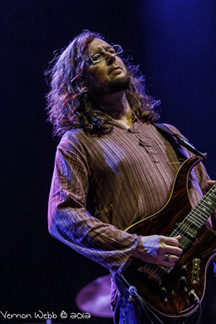Now that Furthur guitarist John Kadlecik is touring with Phil Lesh and Friends, this seemed an opportune time to present this piece written by his fellow Maryland resident Tony Beers.

Photo by Vernon Webb
The Grateful Dead, the San Francisco rock band of epic psychedelic coolness breathes a little easier these days.
The late Jerry Garcia, the band’s guitar player who died in 1995, may have sighed some relief himself In 2009 when mild-mannered guitarist John Kadlecik quietly stepped in, saddled up, and went on the road with the rock icon’s former bandmates, Bob Weir and Phil Lesh.
At the time Kadlecik was minding his own business playing, singing, and recreating the music of The Grateful Dead for thousands of his own adoring fans with the very successful and well-known tribute band he co-founded, Dark Star Orchestra. On an incessant tour schedule throughout the country, surpassed only by the band he emulated, one would think that he would have had his hands full; but just as a minor league baseball player lives for that call from the majors, he answered and headed off to California and a meeting with his idols at their Club Front studios in San Rafael.
Although speaking with John via phone I could hear his excitement over the phone as he talked about creating new material while listening for his own voice, interpreting The Dead’s vast repertoire and his work with Furthur. I began to see more than just a rock star grateful to be able to have fun playing music and getting paid for it (as many artists will admit to). This guy has the humility of a true journeyman. A student of improvisation, Kadlecik works at purveying his goods through live performance and he studies his craft as it unfolds within him.
Kadlecik’s early childhood commitment to music and classical training on the violin, which he picked up at the age of eight, shows in his ease and proficiency on the guitar today. We talked about his musical influences: Camper Van Beethoven, Edie Brickell and the New Bohemians, Jimmy Page, David Gilmore. But it was jazz and the modern psychedelic rock movement that ultimately shaped his career the most.
While he has played with a number of bands (Hairball Willie, Uncle John’s Band, Wing Nut, The Mix w/Melvin Seals), it was Dark Star that helped to establish him as one of today’s foremost improvisational/jam band guitarists.
DSO has been exhaustive in its musical attention to re-creating past Grateful Dead performances using their original set lists. These lists, spanning 30 years, incredibly were never repeated in the same order, nor were the songs played in the quite the same way from one night to the next. What is significant and most often misunderstood about The Dead is that the improvisational nature of the music itself made each song a movement within a larger body of music that was never exactly duplicated. The enormity of the challenge facing Kadlecik and DSO, with over 2000 live Dead shows recorded, was to find that unique sound as a collective musical mind, but also to capture the feel and expression of the band and their epic improvisational repertoire.
“I wanted to look at each individual set list as its own artistic opus, to learn the bigger brush stroke changes that happened in the songs over time,” he said. “DSO was never at any time a note-for-note band. What we did was individually learn our parallel roles, emulating an individual musician in the band and learning how to take a loose structure and fill it out in the same way they might have, not to reproduce a particular show. We strove to play a show as if we could go back in time and they could replay it. The jams would be shorter or longer than theirs were on a given day — we tried to constrain our palettes but not constrain our brushstrokes.”
By all accounts they have accomplished this amazing feat. Dark Star’s unprecedented rise through a sea of talented jambands has given fans worldwide a clinic on a unique brand of music birthed by The Dead and their extraordinary body of work.
I asked John what the biggest difference has been between DSO and playing with “the boys” in the original band.
“Well, in many ways, Dark Star was like being perpetually in university . . . in an academic environment for a bunch of musicians and throwing a good party – whereas going into Further was like getting a real job . . . to make art. I’m not choosing my own curriculum anymore,” he said.


No Comments comments associated with this post